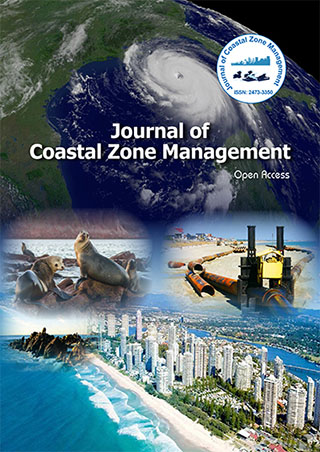Indexed In
- SafetyLit
- RefSeek
- Hamdard University
- EBSCO A-Z
- OCLC- WorldCat
- Publons
Useful Links
Share This Page
Journal Flyer

Open Access Journals
- Agri and Aquaculture
- Biochemistry
- Bioinformatics & Systems Biology
- Business & Management
- Chemistry
- Clinical Sciences
- Engineering
- Food & Nutrition
- General Science
- Genetics & Molecular Biology
- Immunology & Microbiology
- Medical Sciences
- Neuroscience & Psychology
- Nursing & Health Care
- Pharmaceutical Sciences
Perspective - (2024) Volume 27, Issue 6
Strategies for Managing Coastal Erosion: Combining Nature-Based Solutions through Ecological Infrastructure
Eli Cruz*Received: 28-Oct-2024, Manuscript No. JCZM-24-27584; Editor assigned: 30-Oct-2024, Pre QC No. JCZM-24-27584 (PQ); Reviewed: 15-Nov-2024, QC No. JCZM-24-27584; Revised: 22-Nov-2024, Manuscript No. JCZM-24-27584 (R); Published: 29-Nov-2024, DOI: 10.35248/2473-3350.24.27.656
Description
Coastal erosion has long been a significant challenge for coastal communities worldwide, exacerbated by rising sea levels, climate change and human activities. Traditional approaches to managing coastal erosion have largely involved “gray” infrastructure, such as seawalls, groins and breakwaters. While these solutions can provide immediate protection, they often come with long-term environmental drawbacks, including habitat destruction and sediment displacement. In contrast, green infrastructure and Nature-based Solutions (NbS) have emerged as sustainable alternatives, aiming to not only protect coastlines but also enhance ecological resilience and biodiversity.
Green infrastructure refers to the use of natural or semi-natural systems that mimic ecological processes to provide services such as flood protection, water filtration and biodiversity support. In coastal contexts, green infrastructure includes dunes, mangroves, wetlands and living shorelines, which can serve as barriers against storm surges, waves and erosion.
Nature-based solutions (NbS) are broader, encompassing the restoration, conservation, or sustainable management of ecosystems to address societal challenges. In coastal zone management, NbS are employed to mitigate the impacts of coastal erosion while promoting the health of marine and terrestrial ecosystems.
One of the primary advantages of green infrastructure over traditional gray infrastructure is its ability to adapt and evolve over time. Natural systems like wetlands and dunes can regenerate and shift in response to changing environmental conditions, maintaining their protective functions. In contrast, concrete seawalls and other hard structures deteriorate and require costly maintenance and replacement.
Green infrastructure also offers co-benefits beyond erosion control. For instance, mangroves not only protect coastlines from storm surges but also sequester carbon, support fisheries and improve water quality. Similarly, living shorelinesconstructed with natural materials such as oyster reefs, marsh plants and rocks-promote habitat for marine life, contributing to biodiversity.
In the Philippines, the reforestation of mangroves has been instrumental in both mitigating coastal erosion and providing local communities with sustainable livelihoods through fishing and tourism. Mangroves are highly effective at dissipating wave energy and reducing erosion, while also acting as nurseries for marine species.
Despite their benefits, the implementation of green infrastructure and NbS is not without challenges. One major barrier is the initial cost and time required to establish these systems, as they often take years to mature and provide full protective benefits. Additionally, there can be resistance from interesting groups who favor immediate, visible protection provided by gray infrastructure.
Moreover, the success of NbS depends on careful site selection and long-term maintenance. For example, planting mangroves in areas with high wave energy or unstable soil may not lead to successful establishment. Scientific research, community engagement and adaptive management are lead to ensuring the effectiveness of these solutions.
As the impacts of climate change continue to intensify, the need for innovative, sustainable approaches to coastal erosion management is more critical than ever. Green infrastructure and nature-based solutions, providing long-term protection while enhancing ecosystem services. By investing in these solutions, coastal communities can build resilience not only against erosion but also against a wide range of environmental and social challenges. The perspective of coastal management lies in harmonizing human needs with the natural world, creating landscapes that are not only protected but also vibrant and thriving.
Citation: Cruz E (2024). Strategies for Managing Coastal Erosion: Combining Nature-Based Solutions through Ecological Infrastructure. J Coast Zone Manag. 27:656.
Copyright: © 2024 Cruz E. This is an open-access article distributed under the terms of the Creative Commons Attribution License, which permits unrestricted use, distribution, and reproduction in any medium, provided the original author and source are credited.
